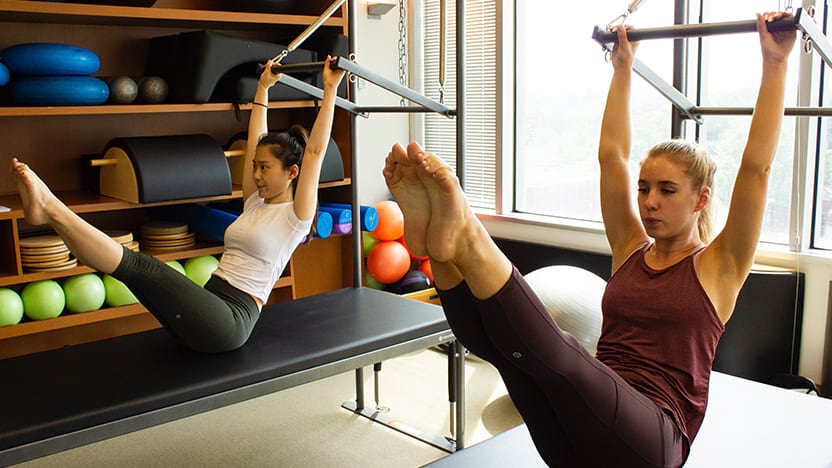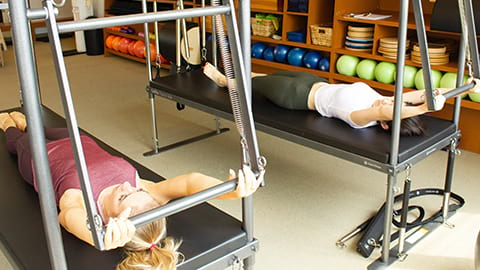In this blog series, Becoming a STOTT PILATES® instructor, we’ll be following Paige Schuman as she progresses through the STOTT PILATES Certification Program, from classwork to teaching hours and exam prep.
Becoming a STOTT PILATES Certified Instructor is a serious undertaking, one that requires students be engaged, determined and committed, as Paige has learned over the last two months.
“We come in at 1 p.m. and stay until 5 p.m. Sometimes our entire day is spent learning new exercises from our Merrithew® Instructor Trainer, or we do two hours of coursework and theory, and two hours of practice,” says Paige, who is enrolled in the Comprehensive stream at the Toronto Corporate Training Center.
“There are hundreds of exercises and we go through every single one to learn what muscles are being used, how to effectively observe, communicate and cue clients, and how to modify the exercises for different clients’ needs.”

Paige began her training at the end of May and has now completed the Level 1 Essential and Intermediate repertoire for Matwork and Reformer, and the Level 1 Essential for Cadillac, Chair and Barrels. Next she’ll be working on her Level 2 Advanced Matwork and Reformer.
She’s now confident in her ability to design and structure group and private classes, progress from a warm-up to a workout, and adapt, layer and integrate props into the repertoire to accommodate different skill levels.
“I always expected the STOTT PILATES Program to provide a thorough education, but the specificity of the teaching and what’s covered is really exceptional,” she says. “You do need to do some studying outside of class hours, but I don’t leave feeling overwhelmed or like things were unclear. Everything is covered in depth and the program is set up to see you succeed. While the education is highly structured and scheduled, they leave us with enough time to review every exercise so we feel confident and understand the movement.”
One component of being a successful instructor is having strong observational and analytical skills, something that students learn to develop in the course, she adds.
“You need to have a keen and clear eye especially because there is a focus on postural analysis, so if your client is kyphotic, you need to know which exercises would be optimal for them. For example, you don’t want to be doing all flexion exercises because they need more extension of the thoracic spine. These people are coming to you for a reason: they know they’ll get a tailored program that is specific to their needs, unlike what is offered in general group fitness classes,” Paige says.
What Paige says she enjoys most about the STOTT PILATES education is how hands-on and interactive it is.
“It’s not like going back to school in the traditional sense. This program is really fun and engaging. We’re shown the exercises, we get to learn them together and practice teaching them. It’s not boring by any means. And what’s really rewarding is knowing that this is going to help me build my dream career. That’s enough motivation to get through the long hours!”
Who is the STOTT PILATES education for?
The students in Paige’s program come from diverse professional backgrounds. While some of them plan on becoming Pilates instructors, others are doing it for their own personal interest and wellbeing.
One student is in the middle of doing a nutrition certificate, a service she plans to pair with her Pilates training. In Paige’s cohort, there’s a physical therapist, a public servant who is taking time off from her day job, and a chef who is utilizing her Pilates training to help her avoid injury in the kitchen.
Regardless of their reasons, Paige says the group works well together.
“I’ve honestly lucked out with this group. Everyone is really nice and even if they’re not in the course to become a Pilates instructor, they’re all positive and excited to learn. It’s been a real pleasure working with them. That’s one of the reasons why I love the fitness world, because people are generally really positive and happy about what they’re doing.”
Any tips for prospective STOTT PILATES students?

“You need to practice. If you don’t review what you learn each day, you’re going to fall behind, especially if you don’t have any previous fitness or anatomy knowledge. If you’re allotted time to practice, take advantage of it. Stay in the studio and go over it all,” she says. “This will also help you avoid being one of those people who then has to spend six months after the program is over coming in and reviewing everything.”
“There is a lot of information to absorb and because the course and the manuals are so detailed, you can look at an exercise one day, go back a few days later, and still learn more. It’s a constant learning experience.”